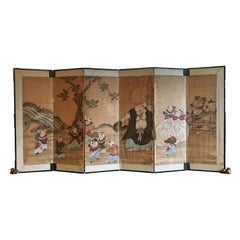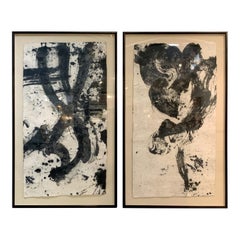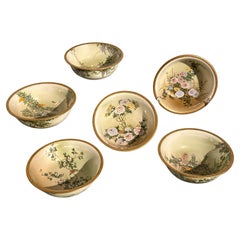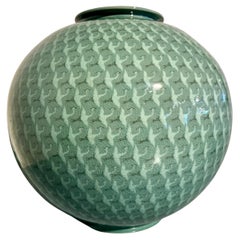Questions & Answers
Our trusted network of 1stDibs sellers answer common questions
What is a Japanese low screen used for?
1 Answer
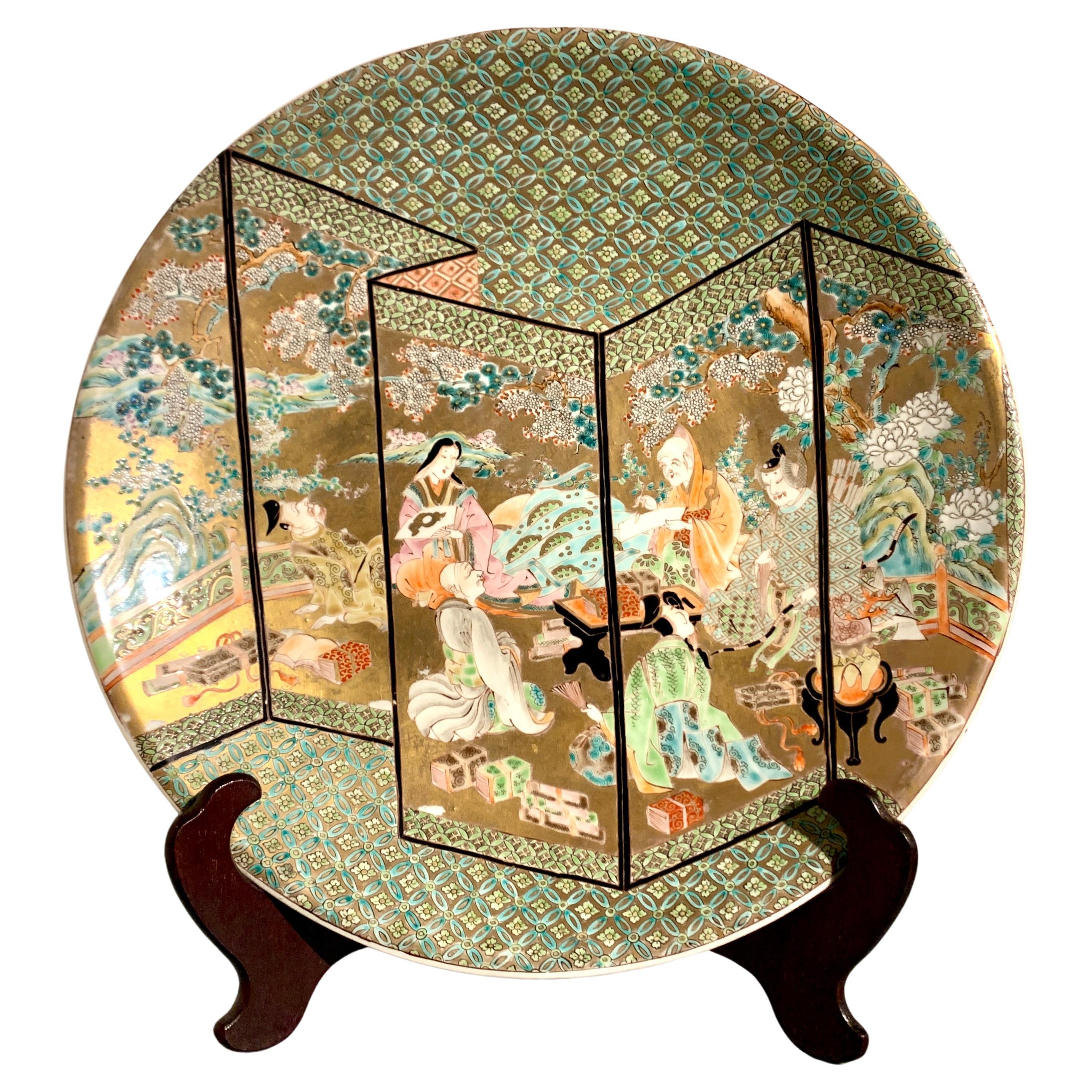
A Japanese low screen was traditionally used while seated upon the floor. The low screen would block wind and drafts, provide limited privacy, and are often decorated with seasonal themes.

Lotus GalleryMarch 17, 2021
Related Questions
- What are Japanese screens called?1 Answer
- What is a Chinese screen?1 Answer
- What is a dressing screen called?1 Answer
- What is a fireplace screen called?1 Answer
- What is the screen in front of a fireplace called?1 Answer
Shop for Japan Screen on 1stDibs
Japanese Six Panel Screen with Hotei, Edo Period, Early 19th Century
Located in Austin, TX
A delightful Japanese six panel painted paper screen featuring the beloved figure Hotei, Edo Period
Category
Antique Early 19th Century Japanese Edo Paintings and Screens
Materials
Silk, Paper
Pair of Japanese Edo Period Six-Panel Screen, "100 Boys at Play"
Located in Austin, TX
An absolutely charming pair of Japanese Tosa School six-panel folding screens painted with the "One
Category
Antique Early 19th Century Japanese Edo Paintings and Screens
Materials
Gold Leaf
Pair Large Framed Japanese Calligraphy "Dragon" & "Tiger", Mid 20th Century
Located in Austin, TX
A large and powerful pair of Japanese calligraphic works, mid 20th century, Japan. One reading
Category
Mid-20th Century Japanese Expressionist Paintings and Screens
Materials
Paper
Large Framed Japanese Buddhist Amida Temple Hall Painting, Mid-19th Century
Located in Austin, TX
A large and incredible Japanese painting of a Buddhist temple hall with Amida Nyorai, late Edo or
Category
Antique Mid-19th Century Japanese Meiji Paintings and Screens
Materials
Wood, Paint, Brocade, Silk, Acrylic
Large Japanese Imari Gilt Charger, the Six Immortal Poets, Meiji Period, Japan
Located in Austin, TX
A bold and unusual large 18.5" diameter Japanese gilt ground Imari porcelain charger featuring the
Category
Antique Early 1900s Japanese Meiji Ceramics
Materials
Porcelain
Shop More furniture from Lotus Gallery on 1stDibs
Six Kinkozan Bowls with Birds and Flowers of the Months, Meiji Period, Japan
By Kinkozan
Located in Austin, TX
A very fine partial set of six Japanese Satsuma bowls decorated with flowers and birds of the months, signed Kinkozan, Meiji Period, circa 1900, Japan.
The set of six exquisitely pa...
Category
Antique Early 1900s Japanese Meiji Ceramics
Materials
Ceramic, Stoneware
Vintage Burmese Reclining Buddha, Carved, Lacquered and Gilt Wood, circa 1970's
Located in Austin, TX
A charming vintage Burmese Mandalay Style carved, lacquered, and gilt wood figure of a reclining Buddha, 1970's, Burma.
The delightful Buddha figure is portrayed resting comfortably...
Category
Vintage 1970s Burmese Sculptures and Carvings
Materials
Wood
Massive Modern Korean Celadon "Thousand Cranes" Moon Jar, 21st Century, Korea
Located in Austin, TX
A large and impressive modern Korean slip inlaid celadon "Thousand Cranes" moon jar attributed to Han Gi Woong, 21st century, South Korea.
The moon jar is decorated all around with ...
Category
2010s Korean Ceramics
Materials
Porcelain
Large Japanese Imari Fluted Charger, Edo/Meiji Period, Mid 19th Century, Japan
Located in Austin, TX
A large and impressive Japanese Imari porcelain fluted charger with scalloped rim, signed Kaji(chu?), Edo to Meiji Period, mid 19th century, Japan.
The magnificent Japanese Imari charger measures 25" in diameter, and is decorated in the typical imari palette of underglaze blue with overglaze red, orange, blue, and green enamels with gilt highlights. The large charger also features fluted sides and a scalloped gilt rim.
The design of the charger is centered on a central floral medallion with three large chrysanthemum blossoms and vegetal scrolls. Radiating out from the central medallion are various brocade patterned sections that roughly follow the shape of the fluting. Some larger sections feature images of cranes and minogame (turtles with long tails), both symbols of longevity, while other feature dragons and phoenix, symbols of authority and power. Four large reserves depict charming scenes of a scholar and his students within a bamboo grove having discourse and examining scrolls.
The back of the charger decorated in underglaze blue with bold floral and vegetal scrolls. With a three character inscription in underglaze blue reading Kaji(chu?) Sei.
The charger is fitted with an antique metal hanger...
Category
Antique Mid-19th Century Japanese Meiji Ceramics
Materials
Porcelain
Burmese Buddha Fragmentary Lacquered Wood Bust, Ava Period, 17th/18th Century
Located in Austin, TX
A mysterious and evocative heavily weathered and fragmentary bust of a Burmese standing Buddha, Ava Period, late 17th or early 18th century, Burma (Myanmar).
The near life-sized im...
Category
Antique Early 18th Century Burmese Sculptures and Carvings
Materials
Metal
Nakajima Yasumi II Bronze "Tomoe" Ikebana Vase, Showa Era, 1960's
By Nakajima Yasumi II
Located in Austin, TX
A striking Japanese patinated bronze ikebana flower vase, "Tomoe", by Nakajima Yasumi II (1905 - 1986), Osaka, Japan.
The highly sculptural vase is crafted of bronze with a spectacu...
Category
Vintage 1960s Japanese Showa Metalwork
Materials
Bronze
Nakajima Yasumi II Bronze "Keifuku" Ikebana Vase, Showa Era, 1960's
By Nakajima Yasumi II
Located in Austin, TX
An elegant Japanese patinated bronze ikebana vase by Nakajima Yasumi II (1905 - 1986), circa 1960's, Osaka, Japan.
The tall vase of graceful form, with a high round foot supporting ...
Category
Vintage 1960s Japanese Showa Metalwork
Materials
Bronze
